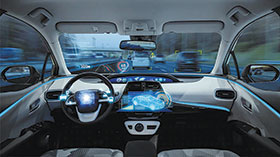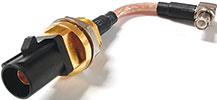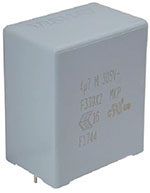

Vehicles are about to become a lot more communicative: with other road users, with the infrastructure they pass on their journeys, with cloud-based services, and even with the energy grid.
This communication should make vehicles more economical to operate, as well as enabling new capabilities. Making such communication possible, though, will mean solving a series of design challenges in a rapidly evolving regulatory environment and complex engineering context.
The auto industry, and the regulators that enable it, have come up with a series of acronyms to denote the various ways in which connected cars will communicate with other entities.
V2V stands for vehicle to vehicle communications. It implies a future in which cars, vans, trucks, and even motorbikes will communicate directly with each other to share information about road conditions and hazards, and to collaborate on managing traffic.
V2I stands for vehicle to infrastructure communications and refers to techniques for connecting cars with road-management systems such as traffic lights and speed signs.
V2N stands for vehicle to network communication, and enables access to, for example, in-vehicle service providers and infotainment streams.
V2G, a lesser used acronym, stands for vehicle to grid, and implies a future in which hybrid and electric vehicles that are on charge become part of an intelligent energy distribution grid, helping to smooth out peaks and troughs in power demand by sourcing or sinking energy as needed.
And there’s even talk of V2P communications, in which, for example, when pedestrians near a crossing their smartphone announces their presence and desire to cross the road to nearby vehicles and infrastructure. Overall, expect to see plenty of mentions of V2X strategies in the next few years.
Each new form of communication will present a challenge and an opportunity to automotive system OEMs, and the component makers that supply them. Their reward for doing the necessary development should be large available markets worldwide.
V2X communications
A recent report by Juniper Research forecasts that more than 62 million vehicles will be capable of V2V communication by 2023; up from just over 1,1 million in 2019. This represents an average annual growth rate of 173% over four years. The study, ‘Consumer Connected Cars: Telematics, In-Vehicle Apps & Connected Car Commerce 2018-2023’, suggests that this year’s introduction of 5G networks will help speed up the roll-out of V2V communications. It predicted that automotive OEMs will gravitate towards 5G networks for V2V communication over other technologies, owing to their lower latency and greater range.
One of the main purposes of V2V communications is to enable greater safety on increasingly crowded roads. The US’s Department of Transport (DoT) has been researching V2V safety for a number of years. Its research programme defined applications for the technology, such as helping drivers to avoid forward collisions, cross intersections more safely, keeping track of hazards in their vehicle’s blind spots, warning when other vehicles are changing lanes, suggesting drivers should not change lanes or pass other vehicles, and warning if other vehicles are out of control.
GSMA, the mobile telecoms association, in its report on Cellular Vehicle-to-Everything (C-V2X) strategies, adds further use cases, such as vehicle platooning, co-operative driving, queue warnings, collecting road tolls, and enabling increasingly autonomous driving.
Radio options
Achieving these benefits demands a flexible and robust radio system that can reliably exchange messages between vehicles at closing speeds of 320 kmph or more, in arbitrary environmental conditions.
The choice of radio technology was apparently settled when the US National Highway Traffic Safety Administration (NHTSA), swiftly followed by the International Standards Organisation, chose the Dedicated Short Range Communications (DSRC) standard as the official wireless technology for V2V. A lobbying group, Intelligent Transportation Systems America, had been asking the Federal Communications Commission to set aside 75 MHz of spectrum around 5,9 GHz for V2V since 1997, and finally succeeded in having it allocated in 2006.
DSRC uses a Wi-Fi-like protocol, IEEE802.11p, which enables communication between fast-moving vehicles by simplifying the process by which a link is established, pushing authentication and security issues up the protocol stack. The technology has a range of about 300 m, has been widely trialled and proven, and is now in commercial operation. There are concerns that there is little room for development with the 802.11p standard, that its latency may be too great to cope with really fast-moving vehicles, and that there could be interference between it and 5 GHz Wi-Fi channels. But for a while, at least, the radio technology choice for V2X communications looked settled.
In April 2019 the European Parliament backed DSRC as the baseline standard for V2V and V2I services, with LTE and 5G for accessing V2N (cloud) services.
Enter, then, the mobile industry, which wants to promote 4G LTE and, eventually, the emerging 5G protocol, to enable V2X instead. C-V2X uses variants of the LTE standard, such as LTE Direct, to enable peer-to-peer V2V and V2I connections without having to access the cellular network. Another variant, LTE Broadcast, will facilitate V2I and V2N functions.
It’s not clear yet whether vehicle makers will go for LTE, LTE Advanced, or 5G as the underlying technology for C-V2X, but they do offer some advantages. The promise of 5G, particularly, is that it supports more simultaneous connections per unit area than previous cellular standards, each communicating at very low latency. This low latency matters because, at closing speeds
of 300 kmph, 10 ms is equivalent to about 80 cm or half a car bonnet’s length – the difference between a collision and just a scare. There’s also an argument to be made that 5G C-V2X strategies will enable more precise positioning and ranging than DSRC.
The US DoT is clearly feeling the pressure from the mobile lobby, since in December 2018 it launched a call for public comments on “the use and integration of Vehicle-to-Everything (V2X) communications technologies into the transportation environment.
“In particular, DoT solicits comment on issues ranging from the use of alternative and emerging communications technologies to support V2X, to the challenges associated with achieving interoperability while accommodating technological change.”
There’s similar uncertainty in Europe. In July 2019, the European Council of Ministers sent back the bill endorsing DSRC to the European Parliament. It is expected to favour, instead, a more ‘neutral’, hybrid approach, in which either technology can be used for V2X communications. This will be good for cellular operators but may call into question the substantial investments that some vehicle makers have already made in enabling and applying DSRC.

Engineering challenges
The engineering challenges involved in implementing V2X technologies are therefore quite complex.
The first, as just discussed, is managing the uncertainty about the protocols and frequency bands that will be used to implement V2X, and, especially for the C-V2X option, the continuing evolution of the 4G and 5G standards as they relate to V2X.
The second issue is achieving reliable and consistent communications, between vehicles and other vehicles, local infrastructure and the network, in arbitrary environmental conditions and complex RF environments. (Think of the mix of RF challenges in a modern car, from Bluetooth-connected headphones to fast-switching inverters to power buses carrying ever higher currents.)
The third issue is the usual automotive equipment suppliers’ challenge, of producing highly reliable equipment that will meet auto makers’ standards while achieving acceptable volume pricing.

Connectivity is obviously a key issue, and Amphenol offers the latest versions of its multigenerational FAKRA RF connection technology (Figure 2), for use in automotive telematics applications including Wi-Fi – and hence DSRC. The parts are meant to connect external automotive devices, and are sealed to IP69K, which should make them proof against powerful water ingress. They are available with colour-coded and keyed shrouds (to prevent mis-keying during assembly), latches, and a wide variety of keying options and colour codes.

EMI suppression is also an issue, with many component makers offering parts to control it in systems ranging from embedded controllers to large switching power supplies. For example, Vishay Intertechnology has introduced the F339X2 series of 305 V a.c. automotive grade X2 EMI suppression film capacitors (Figure 3). They’re qualified to the AEC-Q200 (rev. D) and IEC 60384-14: 2013/AMD1: 2016 grade IIB quality standards. The parts are designed to act as EMC filters for automotive and industrial power inverters.
Amphenol Industrial now offers the SurLok Plus EMI-protection version of its high-current connector and cabling system, for use in hybrid and full electric vehicles. The quick-connect and locking system includes a high-voltage interlock loop safety feature and EMI shielding. Termination options include crimps, screws, or busbars. The parts are meant to provide touch-safe connections to battery packs delivering between 50 A and 400 :A. The cabling system is IP67-rated and can be ordered in sealed and unsealed variants.
Murata is also responding to the challenge of EMI control in an automotive environment. Last year it launched a 0201 inch (0,6 x 0,3 mm) GHz-band, high-impedance ferrite bead noise-suppression filter. The BLM03EB_SH series is meant for use in automotive powertrain and safety applications, to counter the EMI produced by radio modules serving V2X, tolling and related applications.
The small size of the part, as compared to the previous smallest 0402 ferrite bead noise suppressor, should help miniaturise automotive circuitry. Murata also plans to launch similar parts operating at higher frequencies and currents.
Molex also has a wide range of specialist connection products for the automotive industry. The HSAutoLink interconnect system provides a robust, sealed and cost-competitive system that can support data rates of up to 13,5 Gbps, enabling it to carry communication protocols such as LVDS, USB 2.0, USB 3.1, DisplayPort, and the 13,5 Gbps FDP-Link4 standard.
Features include the inclusion of shrouds and latches as standard, ensuring the connectors are rugged enough to meet
USCAR requirements, and support for full-length cable shielding for EMI protection. The connectors also use the proven Molex LFH terminal interface, which is designed to enable high-bandwidth differential signals, with an extended cycle life and stable contact resistance.
These are just some examples of products that will help designers serve the needs of V2X equipment OEMs. While it is unclear how the market will evolve, and which radio system will emerge as the de facto standard, it’s clear that the more that cars communicate, with us, with each other, with the environment they are operating within, and with the cloud, the more care designers will have to take to ensure their messages are always heard clearly.
| Tel: | +27 10 447 0180 |
| Email: | [email protected] |
| www: | www.avnet.com/wps/portal/abacus |
| Articles: | More information and articles about Avnet Abacus |
© Technews Publishing (Pty) Ltd | All Rights Reserved